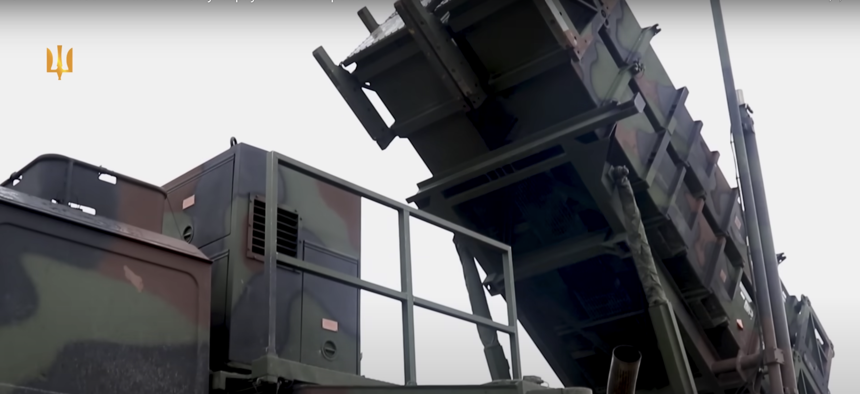
A video screenshot shows one of the Patriot air-defense systems recently arrived in Ukraine. Ukrainian Air Force
In Ukraine, A New Chance to Judge the Patriot Missile
The much-lauded air-defense system has a decidedly mixed record. The Pentagon should watch its performance carefully.
Ukraine is taking delivery of its first Patriot air-defense batteries, the weapon so highly and baselessly lauded during the 1991 Gulf War. Now, as upgraded Patriots take the battlefield once again, U.S. officials must judge how they fare—accurately, this time.
Video released by Ukrainian defense officials show Patriots provided by NATO countries deploying in Ukraine. DOD officials announced on May 3 that U.S.-supplied units have also arrived in country. “In high-intensity combat against the hardest targets, the Patriot can confirm or disprove its widely-regarded reputation as one of the world’s best air defense systems,” wrote Illia Ponomarenko for The Kyiv Independent on May 2.
The weapon has a checkered past. In 1991, U.S. officials and media excitedly reported a 100-percent success rate for the system, with claims that Patriots had intercepted Scud missiles launched from Iraq at Israel and Saudi Arabia. But the following year, Congressional hearings found that these claims were misleading and highly inaccurate. I was the lead staffer for the House Government Operations Committee investigation.
Rather than destroying 41 of 42 Scuds engaged, as President George H.W. Bush claimed at the end of the war, investigators from the Congressional Research Service and the General Accounting Office determined that Patriots only hit between zero and four of 44 Scuds engaged.
The incorrect claims of Patriot PAC-2’s success stem from misunderstanding of the way the interceptor works, how the system gauges its success, and its users’ failure to conduct ground damage assessments to determine whether the target was actually hit.
The PAC-2 variant sprays fragments, like a shotgun blast, as it nears a target. Explosions seen in the sky in the 1991 war were not signs of a Patriot hitting an incoming Scud, but of proximity fuzes detonating as the Patriot neared a Scud or a Scud fragment, or by the missile automatically self-destructing after missing a Scud, or by Patriots flying after false targets.
Nor can the system determine if a Patriot missile actually hits its intended target. It can only determine that it detonated near a point in space where it calculated the target should be, sending back a “probable kill” indicator.
These indicators are inaccurate. In the Gulf War, many of the targets turned out to be debris from the poorly designed Scuds as they broke up in flight. At least 45 percent of the 158 Patriots launched in the war were launched against debris or false targets, the Army reported.
The gap between assumptions and fact appeared during examination of the very first claimed Patriot hit on January 18, 1991. Television viewers were shown images of a Patriot streaking into the cloudy night sky and exploding. Announcers assumed a hit. In fact, there was no Scud there. The congressional investigation uncovered that there was no satellite confirmation of a Scud launch that day, nor was there any ground damage found. The Army confirmed as a result of the investigation that the Patriot system had registered a false target, the result of radar interference from nearby jet aircraft, and launched a Patriot which eventually self-destructed.
As a result of the congressional investigation, the Army revised its claims, saying it only had high confidence that the Patriot hit 25 percent of the Scuds, or 11 missiles. That claim is still higher than independent assessments.
Nonetheless, the myth of the Patriot’s success endures in both official and media sources. For example, the missile-defense lobby still claims the Jan. 18 phantom Scud “was brought down by two Patriot missiles” and “was the first anti-missile missile fired during combat operations.” Exaggerated claims of success against short-range missiles were used then and now to boost proposed budgets and estimates of effectiveness for anti-missile systems against long-range missiles.
Upgrade to PAC-3
In the decade after the Gulf War, the Pentagon upgraded its Patriots to a more effective PAC-3 configuration. While this new version has hit several short-range missiles and drones in combat, it has also mistakenly shot down U.S. and allied aircraft and missed several targets.
The PAC-3 “hit-to-kill” interceptor and improved electronics likely make the newer Patriots more effective at hitting short-range missiles, but there is still doubt.
“I am deeply skeptical that Patriot has ever intercepted a long-range ballistic missile in combat—at the least, I have yet to see convincing unclassified evidence of a successful Patriot intercept,” wrote Jeffrey Lewis in his 2018 review of the Patriot’s performance in Gulf combat.
The system may face just such longer-range missiles in Ukraine, where the military hopes it can intercept Russia’s Su-35 fighters, the S-300/400 missiles now used for surface attacks, and particularly the KH-22 cruise missiles that have devastated buildings in Ukrainian cities. They are not expected to be used against lower-value drone targets; Patriot manufacturer Raytheon charges $4 million for each missile.
It is not clear whether Ukraine is getting PAC-2 or PAC-3 Patriots. “Ukraine’s military did not reveal which version of the Patriot missile system it received,” reports Ponomarenko.
But Ukrainian forces, like the Israeli forces in 1991, will likely be in a good position to use ground debris to help evaluate the results of any Patriot use. They will be able to quickly determine if a system report of a “probable kill” is actually a successful intercept.
The performance of the Patriot system in Ukraine must not be manipulated to promote other agendas. The defense of Ukraine is too important. We all have to hope the Army has absorbed the lessons of past failures and that the new, improved Patriots can provide Ukraine the protection it desperately needs.




